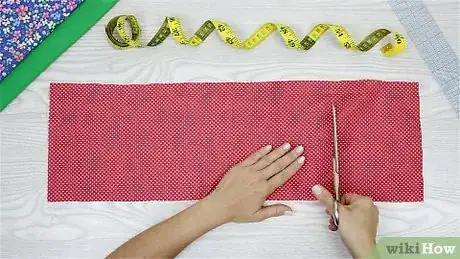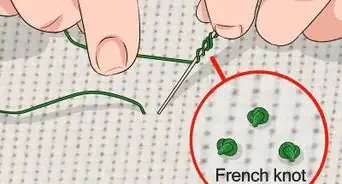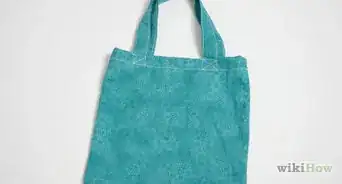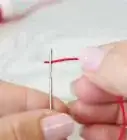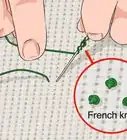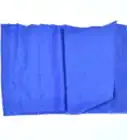This article was co-authored by Mia Danilowicz and by wikiHow staff writer, Jessica Gibson. Mia Danilowicz is a Master Tailor who works onset and on the red carpet in Los Angeles, California. With over a decade of experience, Mia specializes in bridal and gown couturier fittings, garment reconstruction, and custom design. Mia has worked at the Oscars, Grammys, SAG Awards, and Golden Globes. Her clients include a long list of entertainment and fashion industry headliners, major fashion magazines, luxury consumer brands, and popular media. Mia was trained at the Fashion Institute of Design and Merchandising and received her AA in Fashion Design and BS in Business Management.
There are 7 references cited in this article, which can be found at the bottom of the page.
wikiHow marks an article as reader-approved once it receives enough positive feedback. In this case, 100% of readers who voted found the article helpful, earning it our reader-approved status.
This article has been viewed 133,388 times.
If you're new to sewing and looking for an easy project, make a little pouch! You don't need a lot of materials and you'll gain useful sewing skills. If you want to practice making a small pouch, use scrap fabric. In this article, we'll show you step-by-step how to make a handy drawstring pouch and a small folded pouch that comes together in minutes.
Steps
Simple Drawstring Pouch
-
1Cut a piece of fabric into a 7 in × 18 in (18 cm × 46 cm) rectangle. This makes a small pouch, but feel free to make your pouch larger or smaller. If you want different patterns on each side of your pouch, Tailor Mia Danilowicz notes that you can "cut out two matching squares," one from each fabric you want to use. Use your choice of fabric like cotton, canvas, or felt.[1]
- If your fabric is creased or wrinkled, iron it before you cut the rectangle.
- If you're new to sewing, practice making a drawstring pouch using old fabric. You can even cut up an old pillowcase to use for practice!
- To prevent the inside edges from fraying, cut the fabric with pinking shears. You can pick these up at a craft supply store or online.
-
2Fold the rectangle in half so the right sides of the fabric touch. The right side just means the side of the fabric that has the print or color. Bring the short sides of the fabric together and line up the edges so they're even. [2]
- Now, your rectangle measures 7 in × 9 in (18 cm × 23 cm). This will roughly be the dimensions of your fabric pouch.
Advertisement -
3Insert pins along the 2 long sides of the rectangle. To keep the pouch in place as you sew, push a sewing pin through both layers of fabric. Insert a sewing pin every 1 inch (2.5 cm) along the long sides.[3] If you are using squares from two different fabrics, Tailor Mia Danilowicz reminds you to "sew the sides (starting 1" down) and bottoms together" while the bag is inside out.
- If you don't have sewing pins, use sewing clips.
-
4Sew along both of the pinned sides, stopping 1 1⁄2 in (3.8 cm) from the top. Take your pinned fabric to the sewing machine and begin sewing a straight stitch from the folded end of the rectangle up along the pinned side. Leave a 1⁄2 in (1.3 cm) seam allowance and stop sewing when you're 1 1⁄2 in (3.8 cm) from the opposite end of the rectangle—this gives you room to make the drawstring casing at the top of the pouch.[4]
- Don't forget to make a few backstitches before you start sewing the straight stitch and when you finish sewing the side. This locks your stitches in place, so they won't unravel later.
- Remove the pins as you sew, so you don't accidentally damage your machine by stitching over them.
-
5Fold the top edge of the pouch over 2 times and iron it in place. To create the casing for the drawstring, Tailor Mia Danilowicz suggests that you "fold [the top edge of the pouch] down [by] 1⁄2 inch (13 mm)—stitch around [the entire pouch] to create a casing for a drawstring." Then, fold the folded edge over again by another 1 inch (2.5 cm) and iron the fabric, so the folds stay in place.[5]
- Folding the top twice prevents the edge of the fabric from fraying and gives the closure edge a more polished look.
-
6Straight stitch along the folded edge to create the casing. If your pouch is small, remove the optional arm from your sewing machine. This way, you can slide the pouch onto your sewing machine and stitch around the casing—you don't want to accidentally sew your pouch closed! Make straight stitches all around the folded edge.[6]
- Remember to make a few backstitches when you start and stop sewing.
-
7Turn the pouch right side out and cut 2 26 in (66 cm) lengths of ribbon. If you don't want to use ribbon for the drawstring, use a strip of leather cord or any narrow strip of sturdy fabric like denim or canvas.[7]
- You can use shoelaces or the drawstring from an old bag, too.
-
8Attach a safety pin and feed the drawstrings through the casing. Tailor Mia Danilowicz instructs, "pull [the string or ribbon] through using a safety pin or loop turner to push it to the edges so that both strings meet together in the middle." Hook a safety pin on the end of 1 of your drawstrings and push it through the small gap in the casing—you can find it on the side of the pouch near the seam. Work the safety pin through the casing, so it comes back through the gap where you started, and tie the ends of the drawstring ribbon into a knot. Then, repeat this with the other drawstring, but work it through the gap on the opposite side of the pouch. Now, you can pull the drawstrings to close the pouch![8]
- It's fine to use just 1 drawstring—the pouch will close, but it will be a lot more secure with 2 drawstrings.
- It's really important to tie the ends of the drawstring closed or it could slide back into the casing.
Easy Folded Pouch
-
1Cut a piece of felt into a rectangle. If you'd like to make a small pouch, go for a rectangle that's 4 by 8 inches (10 cm × 20 cm). Felt is a great fabric for beginner sewers since it won't fray and it's sturdy enough that you don't need to add interfacing for support. However, feel free to use any fabric you like.[9]
- If you use a fabric like cotton or an acrylic blend, cut a matching piece of fusible interfacing and iron it onto the fabric. This adds support, so your folded pouch will be more stable.
- Make your rectangle larger if you'd like to sew a bigger pouch.
-
2Cut one end of the rectangle to a point if you'd like a pointy fold. Fold the rectangle in half lengthwise and cut a triangle from 1 end of the rectangle. Then, unfold the felt—you'll see 1 end is now pointed like an envelope while the opposite end is still straight.[10]
- If you'd rather have a flat, straight folded edge, skip this step.
-
3Fold the flat end up to the base of the top of the pouch. If you made an envelope point, just line up the corners of the flat edge with the corners at the base of the point. If you kept both ends straight, fold 1 end over until it's 1 1⁄2 inches (3.8 cm) from the end.[11]
-
4Pin the sides of the pouch and straight stitch the sides. Stick 2 or 3 sewing pins along each side to keep the fabric from unfolding. Take the pouch to your sewing machine and make a straight stitch as close to the side as you can. Repeat this on the opposite side and simply fold the top over your new pouch![12]
- If you don't have a sewing machine, this is simple to do by hand—try a blanket stitch or sew a zigzag stitch.
-
5Add a button, snap, or Velcro closure if you like. You don't have to add any of these, but they do help keep your folded pouch closed. Simply sew a button or stitch a snap onto the underside of the fold, and cut a slit for the button, or secure the snap base to the front of the pouch. If you prefer to use Velcro, just cut a piece and stick the corresponding pieces on the fold and the front of the pouch.
- Some types of velcro have to be sewn, so check the product carefully when you're shopping.
Community Q&A
-
QuestionWhat type of fabric do I need to use?
 Community AnswerIt suggests cotton fabric in the materials section at the end of the article. You can find this at any fabric store.
Community AnswerIt suggests cotton fabric in the materials section at the end of the article. You can find this at any fabric store. -
QuestionIs it possible to make a modified version of this to hold a 2DS XL?
 Community AnswerYes. Just measure it and make it slightly larger (for seam allowance, but also to make it easier to take out). The instructions are the same for any length.
Community AnswerYes. Just measure it and make it slightly larger (for seam allowance, but also to make it easier to take out). The instructions are the same for any length. -
QuestionIs it 40 cm wide or long?
 Community AnswerLong, I believe, but you can change the measurements to suit your needs. It could be both, it depends on whether you want a wider opening or larger bag interior.
Community AnswerLong, I believe, but you can change the measurements to suit your needs. It could be both, it depends on whether you want a wider opening or larger bag interior.
Things You’ll Need
Simple Drawstring Pouch
- Fabric
- Scissors
- Iron and ironing board
- Ruler or measuring tape
- Sewing pins
- Sewing machine
- Cord or ribbon
- Safety pin
- Pinking shears, optional
Easy Folded Pouch
- Felt
- Ruler or measuring tape
- Scissors
- Sewing machine, optional
- Button, snaps, or Velcro, optional
References
- ↑ https://4-h.org/about/4-h-at-home/valentines-day/drawstring-treat-bags/
- ↑ https://4-h.org/about/4-h-at-home/valentines-day/drawstring-treat-bags/
- ↑ http://www.gov.pe.ca/photos/original/4h_NRNsewRef.pdf
- ↑ http://www.gov.pe.ca/photos/original/4h_NRNsewRef.pdf
- ↑ https://youtu.be/0OuhGPFVlro?t=250
- ↑ http://www.gov.pe.ca/photos/original/4h_NRNsewRef.pdf
- ↑ https://4-h.org/about/4-h-at-home/valentines-day/drawstring-treat-bags/
- ↑ https://youtu.be/0OuhGPFVlro?t=349
- ↑ https://youtu.be/4wfbQ0dlqBE?t=16
